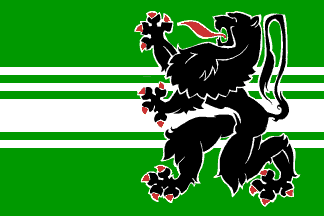 by Mark Sensen
by Mark Sensen
Last modified: 2003-03-21 by ivan sache
Keywords: flanders | lion (black) | east flanders | oost-vlaanderen | flandre orientale | proposal | coat of arms | river | governor |
Links: FOTW homepage |
search |
disclaimer and copyright |
write us |
mirrors
See also:
Michel Lupant gave me a photocopy of the Belgian Gazetteer
(Moniteur Belge/Belgisch Staatsblad) of14 April 1999 Ed.2, in
which the decree of 14 December 1998 was published by which the
Flemish minister of Culture, Family and Welfare imposed (!) flag and
coat-of-arms on the province of East Flanders.
The official description of the flag is (translated from
Dutch/Flemish):
'Three stripes with proportions 5:6:5, the upper and lower stripe
green, the middle stripe alternate white and green with proportions
1:1:1:1:4:1:1, in the fly a black lion with red nails and
tongue.'
The appendix has images of the coat-of-arms and flag.
In the original drawing the lion had three nails at each claw, which was rejected. The original artist refused to change this to four nails, so another artist had to be found to make a new drawing. In this new drawing the lion is less modern than in the original one. Michel Lupant told us that the rejected flag was used unofficially, and that someone had seen a square version.
Mark Sensen, 29 May 1999
Green and white should be the authentic medieval colours of East
Flanders and also represent the increasing concern for environment.
The four white lines represent the rivers which cross the province,
the thickest line representing the Scheldt (Schelde/Escaut).
The colour specifications are:
Jan Cuelenaere, 19 June 1999
This proposal adopted by the Provincial Council was rejected by the Heraldic Council on 21 March 1996 because the lion had only three nails to each paw. Normally an heraldic lion has four nails, but this isn't always the case. See for instance the Greater coat of